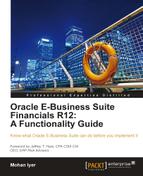Book Description
Expand your existing knowledge of Oracle E-Business Suite and dig deep into the many functionalities of the financial modules. This easy-to-follow guide will help you understand and get started quickly with EBS Financials.
- Take a deep dive into the key elements of Oracle EBS financial transaction processing
- Understand the functionality and critical configuration steps
- Master Oracle EBS product highlights and their effective usage
In Detail
Oracle EBS Financials provide organizations with solutions to a wide range of long- and short-term accounting system issues. Oracle E-Business Suite is the most comprehensive suite of integrated, global business applications that provides the most complete, integrated business intelligence portfolio
Oracle E-Business Suite: A Functionality Guide – helps in binding the two skill sets together – knowledge of the software and the business knowledge of the user.
This guide contains everything you need to know to maximize your implementation payback or return on investment.
This book starts with an overview of Oracle E-Business Suite R12 where we cover the foundation features of Oracle Financial Management modules which include Navigation within Oracle E-Business Suite Release 12, Multiple Organization Access Control (MOAC), key aspects of Application Security and much more. The book then covers in detail General Ledger, Sub Ledger Accounting, Assets, Cash Management, Treasury, E-Business Tax, and much more.
Table of Contents
- Oracle E-Business Suite Financials R12: A Functionality Guide
- Oracle E-Business Suite Financials R12: A Functionality Guide
- Credits
- Foreword
- About the Author
- Acknowledgement
- About the Reviewers
- www.PacktPub.com
- Preface
- 1. Overview of Oracle E-Business Suite
- 2. General Ledger
- 3. Subledger Accounting (SLA)
- 4. Inventory
- 5. Purchasing
- 6. Payables
- 7. Assets
- 8. Cash Management
- 9. Treasury
- 10. Order Management
- 11. Receivables
- 12. Credit Management
- 13. E-Business Tax (EBTax)
- 14. Oracle Workflow
- 15. Approval Management Engine (AME)
